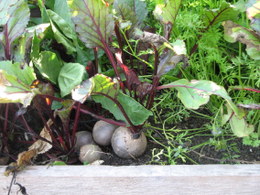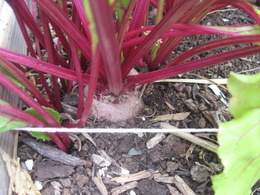Beet Growing Guide
Beets (Beta vulgaris) are native to Europe where they are called beet roots. There are many varieties of beets, some with the common dark red, as well as white, yellow or striped roots. We are most familiar with the round globe shape, but there are longer cylindrical shapes that slice into uniform round slices.
Beets are very nutritious vegetables. The entire plant is edible and is a good source of folates, betaine, lutein and a wide variety of phytochemicals that are good for maintaining and improving your health.
Beets are annual cool weather vegetables and as the weather warms up, they will often bolt and begin flowering prior to making seeds.
Most gardeners think of beets as a root crop, but all parts are edible. The leafy tops, also called greens are very flavorful and nutritious. They can be cooked like spinach.
Starting from Seed
Follow the seed packet instructions, seeds can be started indoors 6 to 8-weeks before your last expected frost date.
Root crops typically do not transplant as well as other root crops. For the root to form properly transplant early while they are still small.
For more detailed information visit the seed starting page.
Soil Preparation
Beets like a nice loose well-drained garden soil in full sun, but can tolerate some light shade, especially during the hot summer weather.
As soon as the soil is frost-free and can be worked, till the soil by digging down 8 to 12-inches turning the soil over with a garden fork. Remove any large and small rocks. Root crops grow best in nice loose rock free garden soil.
Add compost and blend in before planting. They prefer full sun and the soil pH should be 6.0 to 7.0. if your soil pH is below 6.0 add garden lime as directed on the bag.
Planting Beets
Beets are one of the cool weather crops that can be direct sown when the soil has warmed to 45-degrees F and there is no longer a danger of a heavy frost. In most places that would be between 2 to 3-weeks before the last frost.
Sow the seeds ½-inch deep and 1 to 2-inches apart in rows 12-inches apart. Cover with a thin layer of soil. Germination may take 2 to 3-weeks depending on soil temperature.
The beet seed is really a cluster of 2 to 4-seeds. Thin the young plant clusters to 3 to 4-inches apart. It is not necessary to thin them into one plant, since they will naturally push each other apart. The long taproot will hold them in place.
Transplants can be set out in the garden 3 to 4-weeks before the last hard frost, spaced 3 to 4-inches apart in rows 12-inches apart.
Watering and Care
When the plants are a few inches tall add a nice loose mulch of shredded leaves or pine straw to shade the roots. This will keep the weeds out, the soil cooler and help retain moisture. Keep the mulch a couple of inches away from the stem. During dry spells give some water each week.
If needed you can feed with an organic fertilizer such as Espoma Garden-tone.
Harvesting Beets
Depending on the variety, they can be harvested up to about 2 to 2-1/2-inches in diameter. If you let the root get too large, it may tend to get tough and woody.
As they grow you can selectively take a leaf or two from each plant, being careful not to take too many. The green leaves are very tasty either steamed or put in a salad.
When the plant begins to bolt and begins flowering, the energy it receives from the sun, is now being directed into making flowers, instead of going into the roots. This occurs when the temperatures get too warm for it. They should be planted earlier in cool weather. At the first sign of bolting harvest immediately.
Place a garden fork a few inches away from the root and gently loosen the soil from each side as you pull the plant out of the ground.
Diseases
There are several diseases of the leaves such as downy mildew, powdery mildew and leaf spot. These are usually caused by humid wet weather or getting water on the leaves. Bottom watering and increasing air circulation by increasing plant spacing usually helps.
Remove infected plant parts and toss into the trash, not your compost pile.
Pests
Several pests such as aphids, leaf miners and leaf hoppers may occur.
Aphids can be controlled with insecticidal soap or neem oil.
The best strategy to control leaf miners and leaf hoppers is to use a floating row cover over your beets from attacking the leaves. The row cover will also provide some protection from a frost.
The infected leaves should be removed and tossed into the trash, not your compost pile.
To minimize diseases and pests rotate your crops each year.
Popular Varieties
Boldor, Detroit Dark Red, Detroit Golden, Forono, Merlin, Red Ace, Red Titan, Robin, Ruby Queen.
Sources: Seeds Now, Burpee, Park Seed.
Tips and Warnings
Beets have a natural earthy smell and taste. It is an organic compound called ‘geosmin’ that is present in the soil, which we smell right after a rainstorm. It is the smell that we are able to detect at very small levels. In ancient times if you were thirsty the ability to find water was important for survival. If you like beets you learn to enjoy the earthy smell and taste.
Garden Spikes newsletters give you timely information once or twice a month. Subscribe Free to the Garden Times newsletter below.
Your email address will only be used to send you a newsletter and will never be sold. You can unsubscribe at any time.


